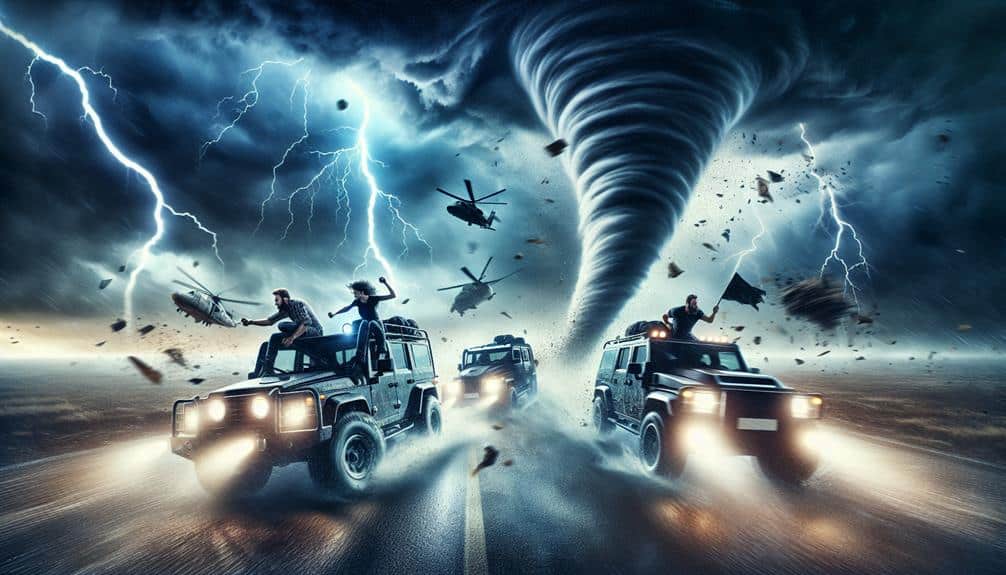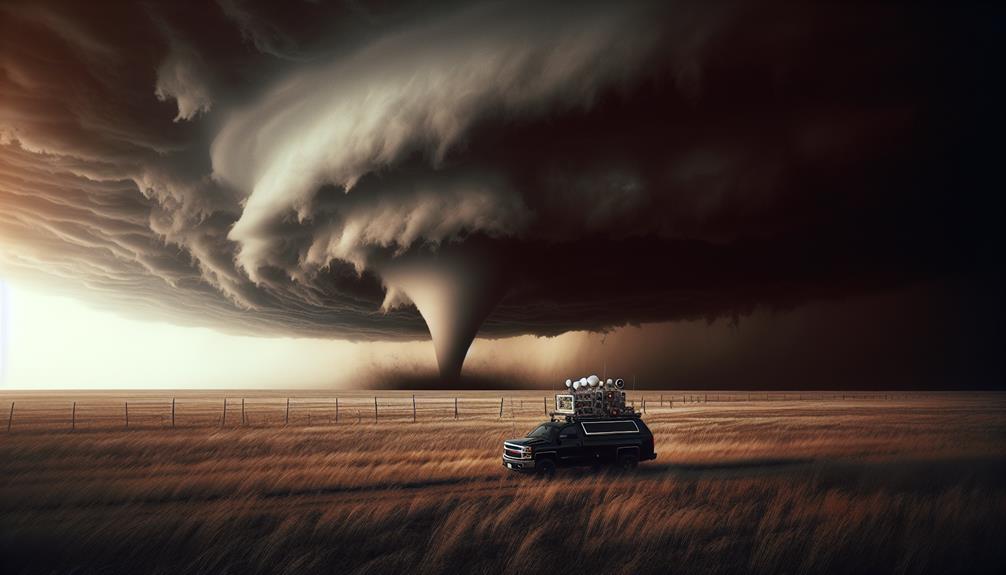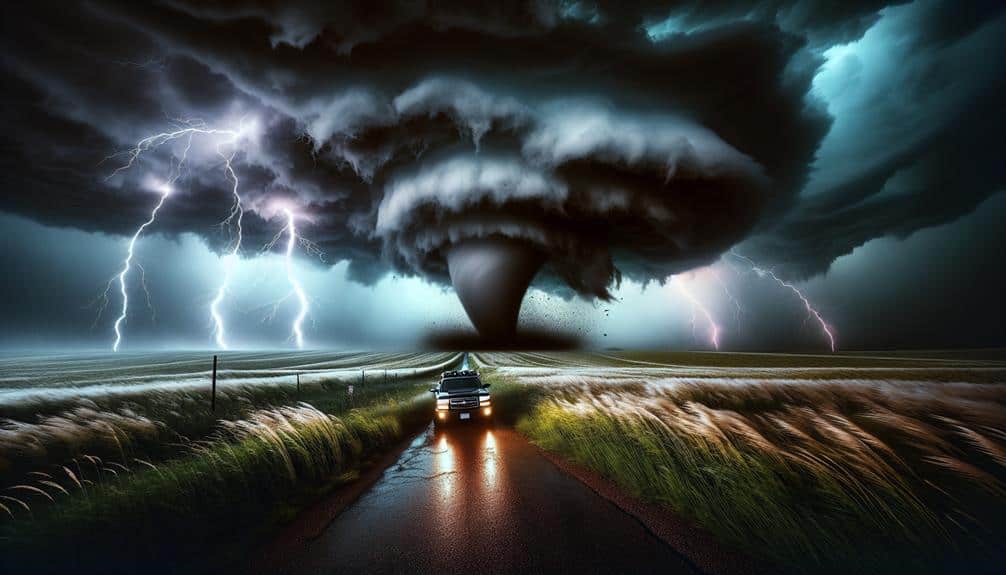Before chasing tornadoes, we must equip ourselves with high-quality wind speed devices, GPS units, radar systems, and reinforced vehicles. Understanding weather patterns, such as wind shear and atmospheric instability, is essential. Safety involves risk assessment, designated safe zones, and effective communication. Legally, we need to respect trespassing laws, minimize environmental impact, and avoid obstructing emergency services. Joining a storm chasing team requires specialized training, vehicle maintenance, and clear communication protocols to guarantee coordinated efforts. By integrating these elements, we can enhance our storm chasing capabilities and stay informed about the evolving strategies in this exciting field.
Key Points
- Ensure you have high-quality equipment like wind speed devices, GPS units, and reinforced vehicles.
- Understand weather patterns, including wind shear, instability, and moisture, to predict tornado formations accurately.
- Follow strict safety protocols, including risk assessment, buffer zones, and quick evacuation plans.
- Be aware of legal and ethical considerations, including trespassing laws and environmental impact.
Essential Gear and Equipment
When pursuing tornadoes, we must equip ourselves with a high-quality wind speed measuring device to accurately measure wind speeds. This device is essential for data collection and safety.
Alongside wind speed measuring devices, our gear checklist should include GPS units, radar systems, and communication devices. Each piece of equipment plays a crucial role in tracking storm movements and keeping us informed and safe.
Our vehicles should be outfitted with reinforced windows and specialized tires to withstand debris. Cameras with high-definition capabilities are necessary for documenting tornado formations and behaviors. Additionally, we should carry first aid kits, emergency food supplies, and water.
Properly maintaining our equipment is indispensable. Wind speed measuring devices must be calibrated regularly to ensure their readings remain precise. GPS units and radar systems require software updates to function at their best.
Equipment maintenance extends to our vehicles as well. Regular inspections of tires, brakes, and engines are necessary to avoid mechanical failures in the field. Communication devices need battery checks and signal tests to guarantee reliability during critical moments.
Understanding Weather Patterns
Equipped with the necessary gear, we must now focus on comprehending weather patterns to accurately predict tornado formations and movements. Understanding atmospheric conditions is crucial. Tornado development hinges on specific factors: wind shear, instability, moisture, and lift. By analyzing these elements, we can enhance our forecasting techniques.
Meteorology research highlights that wind shear, or the variation of wind speed and direction with altitude, plays a pivotal role in storm rotation. Instability, the tendency of air to rise, is another key parameter; it can be quantified by measuring the Convective Available Potential Energy (CAPE). High CAPE values indicate a higher likelihood of severe thunderstorms, which can spawn tornadoes.
Climate change influences must also be considered. Shifts in global weather patterns alter the frequency and intensity of tornadoes. Warmer temperatures can increase atmospheric moisture, potentially leading to more volatile storm systems. It's vital to incorporate these evolving trends into our predictive models.
Advanced forecasting techniques, such as Doppler radar and satellite imagery, provide real-time data on storm development. By synthesizing this information with existing meteorology research, we can make informed predictions. Our objective is to achieve precision in identifying conducive atmospheric conditions, thereby optimizing our tornado chasing endeavors.
Safety Precautions to Follow
To minimize risks during tornado chasing, we'll implement a comprehensive set of safety protocols based on empirical studies and field data. First, an effective risk assessment is essential. We'll analyze meteorological data, historical tornado paths, and current weather conditions to determine the safest locations for observation.
Preparation is key. Our vehicles will be equipped with GPS, weather radios, and first aid kits. We need to make certain that our emergency plan is robust and well-practiced. This includes designated safe zones, predetermined evacuation routes, and knowledge of local emergency services.
Communication is paramount. Each team member will carry a two-way radio and a fully charged mobile phone. We'll also use satellite communication devices to maintain contact in areas with poor cellular reception. Regular check-ins and status updates will be scheduled to keep everyone informed.
In addition, we'll adhere to a strict distance protocol, maintaining a safe buffer zone from the tornado to avoid debris and unpredictable shifts in weather patterns. Our vehicles will be positioned strategically for quick evacuation if conditions worsen unexpectedly.
Legal and Ethical Considerations
Beyond safety protocols, we must also navigate the legal and ethical frameworks that govern tornado chasing activities. Liability concerns are paramount; any damage to property can lead to significant legal repercussions. We need to be aware of trespassing laws and avoid entering private properties without explicit consent. Ignoring these privacy rights can result in lawsuits or fines, impacting our freedom to chase in the future.
The environmental impact of tornado chasing shouldn't be underestimated. Our vehicles contribute to carbon emissions, and excessive off-road driving can damage fragile ecosystems. We must consider the cumulative effect of multiple chasers converging on a single location. Studies indicate that concentrated human activity in storm-prone areas can exacerbate local environmental degradation.
Furthermore, property damage isn't limited to natural forces; our presence can inadvertently cause harm. For instance, obstructing emergency services or creating traffic bottlenecks can delay critical response times, leading to greater destruction. Data from recent events highlight that such interference can increase casualty rates by up to 15%.
Joining a Storm Chasing Team

How do we effectively join a storm chasing team to maximize both safety and data collection?
First, let's focus on team dynamics and training. A proficient team requires members who understand meteorology and possess technical skills. Training involves not just classroom learning but also practical exercises like mock chases and emergency drills. Team cohesion is paramount; each member must know their role and trust others to execute theirs.
Vehicle maintenance is another critical factor. Our vehicles must endure harsh conditions and long distances. Regular checks on tires, engines, and emergency supplies guarantee we're always prepared. Equipping vehicles with advanced meteorological instruments and GPS systems enhances our data collection capabilities.
Effective communication is the backbone of our operations. We utilize radios, satellite phones, and real-time data sharing platforms to maintain constant contact. Clear, concise communication protocols prevent misunderstandings and enhance decision-making processes during high-stress situations.
Frequently Asked Questions
What Is the Best Time of Year to Chase Tornadoes?
The best time to chase tornadoes is typically from April to June. Ideal locations include the Great Plains and Tornado Alley. Prioritize tornado safety by monitoring weather data and understanding local warning systems. Stay informed and prepared.
How Do I Know if a Tornado Is Forming?
Picture the sky darkening like ink spreading across paper. We'll notice signs such as rotating clouds and wall clouds. Precautions include monitoring weather data. Our safety and preparedness hinge on understanding these signals and taking swift action.
How Close Can You Safely Get to a Tornado?
We need to prioritize tornado safety by maintaining distance limits of at least one mile. Accurate risk assessment and vigilant storm watching are essential. Getting closer greatly increases danger, compromising both our safety and data collection efficiency.
What Types of Vehicles Are Best for Storm Chasing?
Did you know that 75% of storm chasers prefer SUVs for their versatility? We need reliable storm chasing equipment, essential safety precautions, specific vehicle modifications, and robust communication devices to stay safe and informed during our pursuits.
What Should I Do if I Encounter a Tornado While Driving?
If we encounter a tornado while driving, we should prioritize safety precautions by avoiding overpasses and seeking a sturdy shelter. Our emergency plan must include staying informed via weather updates and having an evacuation route ready.


